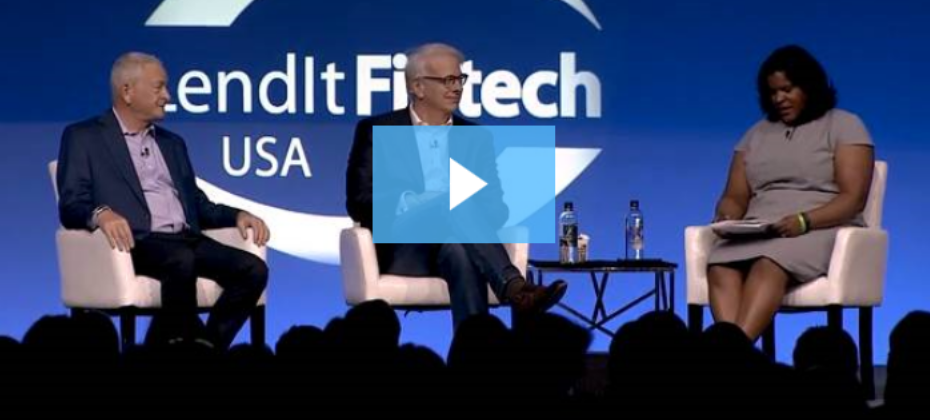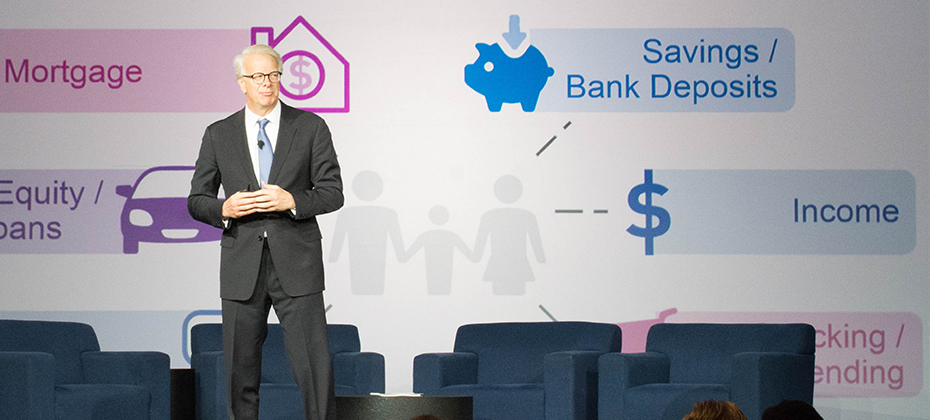Tag: digital technology

Earlier this month, Experian joined the nation’s largest community of online lenders at LendIt Fintech USA 2019 in San Francisco, CA to show over 5,000 attendees from 50 countries the ways consumer-permissioned data is changing the credit landscape. Experian Consumer Information Services Group President, Alex Lintner, and FICO Chief Executive Officer, Will Lansing, delivered a joint keynote on the topic of innovation around financial inclusion and credit access. The keynote addressed the analytical developments behind consumer-permissioned data and how it can be leveraged to responsibly and securely extend credit to more consumers. The session was moderated by personal finance expert, Lynnette Khalfani-Cox, from The Money Coach. “Consumer-permissioned data is not a new concept,” said Lintner. “All of us are on Facebook, Twitter, and LinkedIn. The information on these platforms is given by consumers. The way we are using consumer-permissioned data extends that concept to credit services.” During the keynote, both speakers highlighted recent company credit innovations. Lansing talked about UltraFICO™, a score that adds bank transaction data with consumer consent to recalibrate an existing FICO® Score, and Lintner discussed the newly launched Experian Boost™, a free, groundbreaking online platform that allows consumers to instantly boost their credit scores by adding telecommunications and utility bill payments to their credit file. “If a consumer feels that the information on their credit files is not complete and that they are not represented holistically as an applicant for a loan, then they can contribute their own data by giving access to tradelines, such as utility and cell phone payments,” explained Lintner. There are approximately 100 million people in America who do not have access to fair credit, because they are subprime, have thin credit files, or have no lending history. Subprime consumers will spend an additional $200,000 over their lifetime on the average loan portfolio. Credit innovations, such as Experian Boost and UltraFICO not only give consumers greater control and access to quality credit, but also expand the population that lenders can responsibly serve while providing a differentiated and competitive advantage. “Every day, our data is used in one million credit decisions; 350 million per year,” said Lintner. “When our data is being used, it represents the consumers’ credit reputation. It needs to be accurate, it needs to be timely and it needs to be complete.” Following the keynote, Experian, FICO, Finicity and Deserve joined forces in a breakout panel to dive deeper into the concept of consumer-permissioned data. Panel speakers included Greg Wright, Chief Product Officer at Experian’s Consumer Information Services; Dave Shellenberger, Vice President of Product Management at FICO; Nick Thomas, Co-Founder, President and Chief Technology Officer at Finicity, and Kalpesh Kapadia, Chief Executive Officer at Deserve. “As Alex described in today’s keynote, consumer-permissioned data is not a new concept,” said Greg Wright. “The difference here is that Experian, FICO and Finicity are applying this concept to credit services, working together to bring consumer-permissioned data to mass scale, so that lenders can reach more people while taking on less risk.” For an inside look at Experian and FICO’s joint keynote, watch the video below, or visit Experian.com and boost your own credit score.

With the number of consumer visits to bank branches having declined from 52% of people visiting their bank branch on a monthly basis to 32% since 2015, the shift in banking to digital is apparent. Rather than face-to-face interaction, today’s financial consumers value remote, on-demand, services. They expect instant credit decisioning, immediate account funding, and around-the-clock customer assistance. To adapt, financial service providers see the necessity to respond to consumers’ growing expectations and become part of their overall digital lifestyle. Here are a few ways that financial services can adjust to changing consumer behavior: Drive mobile app activity With more than 50% of the world’s population actively using smartphones, the popularity of mobile banking apps has soared. Mobile apps have revolutionized the banking sector by facilitating easier communication between clients and institutions, offering value-added services, and introducing blockchain technologies. Consumers use mobile banking apps to pay bills, transfer funds, deposit checks, and make person-to-person payments. In fact, according to a study by Bank of America, more than 60% of millennials use mobile apps to make person-to-person payments on a regular basis! Financial institutions who launch new, or invest in enhancing existing mobile apps, can lower their overall costs, increase ROI, and maintain customer loyalty. Provide convenience and rewards CGI conducted a survey on emerging financial consumer trends, focusing on bank customers’ top requirements. Results confirmed that 81% of respondents expected to receive some form of an incentive from their primary banks. Today’s financial consumers may reasonably be won over by service offerings. They want rewards, limited fees, and convenience. As an example, Experian’s Text for CreditTM simplifies the credit process by providing customers with instant credit decisioning through their mobile devices. Personalized offers based on customer behavior can help enhance your brand and attract new customers. Stay connected Today’s consumers expect instant service and gratification. Consumers prefer to work with banks who offer accessible and responsive customer service. According to a recent NGDATA consumer banking survey, 41% of banking customers report that poor customer service is the primary reason they would leave their bank. Mintel suggests developing an omnichannel experience aligned with consumer media consumption. Stay connected with consumers through mobile apps, chatbots, social media, and email. Ensure that all interactions are relevant and helpful and immediately alert customers of any institutional issues or changes. The growing digital demands of consumers are influencing how people purchase banking, lending, and credit services. These changes are driving increased urgency for financial service institutions to adopt real-time financial processes that meet demands for convenience and speed. Interested in more best practices? Watch our On-Demand Webinar

While it’s a word that has only recently made its way into financial circles, consumers and businesses alike have been enjoying life in a platform world. Digital platforms connect riders with drivers, friends with family, manufacturers with buyers and sellers, and the list goes on. Digital platforms are technology-enabled business models that work to enhance efficiency, flexibility, scalability, integration, and ultimately user engagement. They’re integral to the operation and success of some of the most valuable companies in the world, including Google, Facebook, and Amazon. While digital platforms have made their way beyond high-tech to other industries, like supply chain management and logistics, financial institutions have fallen behind. The reasons why are understandable: a quickly evolving marketplace, regulatory induced risk aversion, and the need to protect data and privacy. Most of the digital platform adoption that has occurred in the financial industry has revolved around open banking, with a focus on enriching the customer experience. BBVA, for instance, recently launched a platform to enable their business clients to use white-labeled versions of BBVA products and services on-demand. But the value of digital platforms for the financial industry can go beyond how the consumer interfaces with his or her bank or credit union. Financial institutions could see the same efficiency, flexibility, and integration benefits by implementing technology platforms into their internal systems. Traditionally, financial institutions have used contrasting technology and systems across their customers’ lifecycle. From financial marketing and targeting, to acquisition and underwriting, there is ample opportunity to streamline and integrate these systems by adopting a platform architecture. The most future-forward platforms not only enable financial institutions to integrate their internal systems, but they also allow companies to seamlessly integrate their customer data with third-party data resources. The powers of data-driven answers combined with platform technology can help overcome business challenges and satisfy consumer and client demands. Is it time you and your company stepped up to the platform?

So many insights and learnings to report after the first full day of 2017 Vision sessions. From the musings shared by tech engineer and pioneer Steve Wozniak, to a panel of technology thought leaders, to countless breakout sessions on a wide array of business topics … here’s a look at our top 10 from the day. A mortgage process for the digital age. At last. In his opening remarks, Experian President of Credit Services Alex Lintner asked the audience to imagine a world when applying for a mortgage simply required a few clicks or swipes. Instead of being sent home to collect a hundred pieces of paper to verify employment, income and assets, a consumer could click on a link and provide a few credentials to verify everything digitally. Finally, lenders can make this a reality, and soon it will be the only way consumers expect to go through the mortgage process. The global and U.S. economies are stable. In fact, they are strong. As Experian Vice President of Analytics Michele Raneri notes, “the fundamentals and technicals look really solid across the countries.” While many were worried a year ago that Brexit would turn the economy upside down, it appears everything is good. Consumer confidence is high. The Dow Jones Index is high. The U.S. unemployment rate is at 4.7%. Home prices are up year-over-year. While there has been a great deal of change in the world – politically and beyond – the economy is holding strong. The rise of the micropreneur. This term is not officially in the dictionary … but it will be. What is it? A micropreneur is a business with 0 to 4 employees bringing in no more than $200k in annual revenue. But the real story is that numbers show microbusiness are improving on many fronts when it comes to contribution to the economy and overall performance compared to other small businesses. Keep an eye on these budding business people. Fraud is running fierce. Synthetic identity losses are estimated in the hundreds of millions annually, with 50% year-over year growth. Criminals are now trying to use credit cleaners to get tradelines removed from used Synthetic IDs. Oh, and it is essential for businesses to ready themselves for “Dark Web” threats. Experts advise to harden your defenses (and play offense) to keep pace with the criminal underground. As soon as you think you’ve protected everything, the criminals will find a gap. The cloud is cool and so are APIs. A panel of thought leaders took to the main stage to discuss the latest trends in tech. Experian Global CIO Barry Libenson said, “The cloud has changed the way we deliver services to our customers and clients, making it seamless and elastic.” Combine that with API, and the goal is to ultimately make all Experian data available to its customers. Experian President of Decision Analytics Steve Platt added, “We are enabling you to tap into what you need, when you need it.” No need to “rip and replace” all your tech. Expect more regulation – and less. A panel of regulatory experts addressed the fast-changing regulatory environment. With the new Trump administration settling in, and calls for change to Dodd-Frank and the Consumer Financial Protection Bureau (CFPB), it’s too soon to tell what will unfold in 2017. CFPB Director Richard Cordray may be making a run for governor of Ohio, so he could be transitioning out sooner than the scheduled close of his July 2018 term. The auto market continues to cruise. Experian’s auto expert, Malinda Zabritski, revealed the latest and greatest stats pertaining to the auto market. A few numbers to blow your mind … U.S. passenger cars and light trucks surpassed 17 million units for the second consecutive year Most new vehicle buyers in the U.S. are 45 years of age or older Crossover and sport utility vehicles remain popular, accounting for 40% of the market in 2016 – this is also driving up finance payments since these vehicles are more expensive. There are signs the auto market is beginning to soften, but interest rates are still low, and leasing is hot. Defining alternative data. As more in the industry discuss the need for alternative data to decision, it often gets labeled as something radical. But in reality, alternative data should be simple. Experian Sr. Director of Government Affairs Liz Oesterle defined it as “getting more financial data in the system that is predicted, validated and can be disputed.” #DeathtoPasswords – could it be a reality? It’s no secret we live in a digital world where we are increasingly relying on apps and websites to manage our lives, but let’s throw out some numbers to quantify the shift. In 2013, the average U.S. consumer had 26 online accounts. By 2015, that number increased to 118 online accounts. By 2020, the average person will have 207 online accounts. When you think about this number, and the passwords associated with these accounts, it is clear a change needs to be made to managing our lives online. Experian Vice President David Britton addressed his session, introducing the concept of creating an “ultimate consumer identity profile,” where multi-source data will be brought together to identify someone. It’s coming, and all of us managing dozens of passwords can’t wait. “The Woz.” I guess you needed to be there, but let’s just say he was honest, opinionated and notes that while he loves tech, he loves it even more when it enables us to live in the “human world.” Too much wonderful content to share, but more to come tomorrow …

Using digital technology like a big bank How was your holiday? Are the chargebacks rolling in yet? It’s no secret - digital technology like mobile device usage has increased significantly over the years, making it a breeding ground for fraudsters. As credit unions continue to grow their membership, their fraud security treatments need to grow as well. Bigger banks are constantly updating their fraud tools and strategies to fight against cybercrime and, therefore, fraudsters are setting their eyes on credit unions. Even as I write this, fraudsters are searching and targeting credit unions that don’t have their mobile channel secured. They attempt to capitalize on any weakness or opportunity: Registering stolen cards to mobile wallets Taking over an account via mobile banking apps Using a retailers’ mobile app to make fraudulent payments Disabling the SIM card in the victim’s phone and diverting the one-time password sent through text message to their own phones These are clever ways to commit fraud. But credit unions are becoming wise to these new threats and are serious about protecting their members. They are incorporating device intelligence with a solid identity authentication service. This multi-layered approach is essential to securing mobile channels, and protecting your Credit Union from chargebacks. To learn more about our fraud solutions, click here.